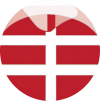Hey guys, do you know what celebrated its 60th birthday on May 14? Guessed right – the bird flight line! But hey, just because she’s reached her sixties now doesn’t mean she has to retire. Quite the opposite! These ferries between Puttgarden and Rødby have really taken off in the last ten years, especially in terms of environmentally friendly operation and sustainability.
Imagine, in 1963 this line was inaugurated. That was a full 18 years after the end of World War II. At the time, zero emissions and sustainability weren’t exactly in the spotlight. One could still feel the aftermath of the war, and this was clearly emphasized at the opening.
The then German President Heinrich Lübke and the Danish King Frederik IX emphasized that this ferry connection would contribute to the cultural and political understanding between the two countries. They even had a vision that this ferry route should promote European cooperation. There’s something poetic in that, isn’t there?
When the Vogelfluglinie was opened, it belonged to Deutsche Bundesbahn on the German side and DSB (Danske Statsbaner) on the Danish side. Although each cooked its own soup, in 1997 they merged and purchased four new ferries – the so-called double-ended ferries, which, by the way, are still in use. Even then, these ferries were designed to be future-proof. They actually have diesel-electric engines installed. The guys must have had a plan to replace these diesel generators with newer technologies as soon as they became available.
And you know what? Today you can take a look in the engine room, on the bridge or even in the galley and see how much the Vogelfluglinie keeps up with the times. Back in 1998, they used a simulator in Puttgarden to save fuel. Then, in the 2000s, exhaust boilers were installed and the ship’s hulls were optimized to reduce fuel consumption while underway. Finally, in 2013, they had a new technology that allowed them to combine diesel engines with batteries. And poof, they have converted the first of a total of four Scandlines ferries to hybrid. This was an important step towards emission-free ferry operation.
Today you can take a look at the battery banks for the hybrid system in the engine room of these passenger ferries. There are automated screens that monitor power consumption. They’re even doing something about food waste in the galley – instead of buffets, they’re now serving delicious
ere plate dishes. And do you know what happens below the waterline? The ferries got a fancy silicone paint job to help them glide through the water more easily. In addition, all ferries have new, low-noise thrusters. Not only do the porpoises in the Fehmarnbelt now have their peace and quiet, but the ships also consume less fuel during their voyages. Pretty cool, right?
Since the opening of the Vogelfluglinie in 1963, over 315 million passengers have been transported across the Fehmarnbelt. With so many people, of course, the port terminals have to keep up. That’s why electronic solutions are now available to make check-in lightning fast. And do you know what comes next? Automatic check-in systems with license plate recognition for trucks and cars. That’s just insane!
These were just a few examples of how the 60-year-old ferry route is moving with the times. It is often even ahead of its time. And do you know what will happen in 2024? That’s when the brand new PR24 electric ferry is put into service on the Vogelflug line. It’s enough to make you salivate!
So guys, if you want to visit Denmark, don’t forget to take advantage of this cool ferry service. The Bird Flight Line is not only a piece of history, but also a prime example of sustainable travel. So grab your bags and hit the road, the bird flight line is waiting for you!

